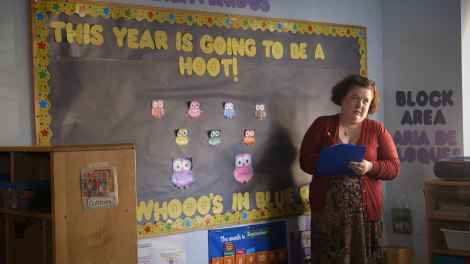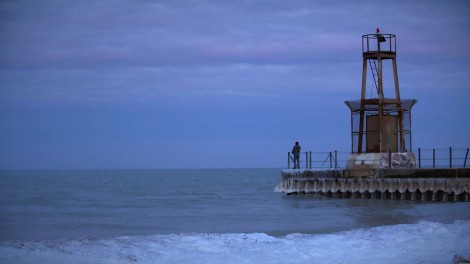Directed by: Kyle Henry
Written by: Carlos Treviño
Starring: Christine Horn, Jonny Mars, Antoine McKay, Sara Sevigny
Produced by: Kyle Henry, Jason Wehling
Executive Produced by: Alan Berg, Louis Black
Music by: Curtis Heath
Cinematography by: Drew Xanthopoulos
Editing by: John Fecile
*Rogers Park opens at the Austin Film Society on March 23.*

Christine Horn (left) and Jonny Mars as “Deena” and “Chris”. Courtesy Rogers Park.
*****
“Treat everyone you meet as if they are God in drag.” – Ram Dass
*****
Rogers Park, the new feature from director Kyle Henry and screenwriter Carlos Treviño, is as refreshing as a glass of cold water to the face, and just as intense.
Roaming as it does between a quartet of stressed, depressed, and repressed residents of the Chicago neighborhood of its title, the film – which Henry produced with Jason Wehling, of Austin’s Arts + Labor – creates an unrelenting cyclone of miserable circumstances that many in this country will instantly recognize.
The inherent challenge of Treviño’s script is that its characters’ troubles hit so close to home that those of us in the midst of similar trials might find it unwatchable for the time being.
That quartet is a family, of sorts: there is Chris (Jonny Mars, never anything but exceptionally present), a struggling writer whose rage is as tightly coiled inside as the man-bun on top of his head; Deena (the quietly powerful Christine Horn), a community activist whose role as Chris’s long-time girlfriend has mutated into something much uglier; Zeke (Antoine McKay, of Empire), an affable real-estate agent up to his neck in overdue house payments; and Zeke’s wife Grace (Sara Sevigny), who conceals the wounds she shares with Chris, who is also her brother, behind a veil of ersatz cordiality.

Sara Sevigny as “Grace”. Courtesy Rogers Park.

Jonny Mars (left) and Christine Horn. Courtesy Rogers Park.
Each of the actors was selected in a unique race- and gender-blind casting process intended to reflect the ethnographic diversity of the real Rogers Park. It is an intriguing gambit, the most substantial benefit of which is the sense that we have seen these folks before: in our libraries, on the streets, getting their coffees.
Henry and Treviño introduce them in the middle of what some might call their midlife crises, but which in a modern context resembles something closer to a collective existential breakdown.
Though the opening credits show four people moving normally through their daily lives, the walls of comfort crumble soon after Chris stages a confrontation with Grace at a party celebrating one of Zeke’s sales.
From that disturbing sequence – a tour-de-force for both Sevigny (a true standout) and Mars, in a much-anticipated lead role following strong work in last year’s Discreet – onward, Rogers Park morphs into a series of increasingly painful conversations, each centered on the factors eroding its protagonists’ well-being.
Deena, for example, is severely undervalued and underloved, facts that even her progressive relationship with Chris won’t solve. And the kindly Zeke, who McKay invests with the natural intellect of the Everyman, cannot seem to keep two feet on the ground financially.

Antoine McKay as “Zeke”. Courtesy Rogers Park.
These are the concerns of the paradigmatic contemporary American, and director Henry, for whom cinema is always an opportunity to cast a wide empathy net, does not allow the viewer to avoid facing any of them head-on.
He stages each argument in an excruciating realism, letting his actors breathe through their anger (imagine the cast of Who’s Afraid of Virginia Woolf? going raw from yelling, and you’ll get some idea of the ferocity Henry’s cast brings.) To look away would be a cowardly act, this tells us, even though it will be the natural instinct of many.
Visually, the gifted cinematographer, Austin’s own Drew Xanthopoulos, captures every tear-drop, every greasy lock of hair, and every anguished cry in close-up. Henry has said that he favors unobtrusive camerawork, and in this, Xanthopoulos succeeds tremendously.
There is no mugging for the camera, no bombastic monologues, only the unadulterated exchange of pain. This is a film told in faces.
Xanthopoulos also makes the quietly inspired choice to match his cast’s eyelines in conversation, despite their varying heights. Why is this technique, which is habitual for many filmmakers, so powerful in practice here? Because when no one character is privileged with a more flattering subjective angle, it reinforces the idea that all the people on screen are equals.

Courtesy Rogers Park.

Courtesy Rogers Park.
In this way – and as the filmmakers surely intended – we come to learn the deep traumas that influence these characters, who emerged organically through a mix of community table-reads, talk-backs, and extensive rehearsal with the actors.
This process takes a notable toll, however. Trevino’s script (his solo feature debut; he also wrote three of the segments in Henry’s visionary anthology, Fourplay) does indeed feel heavily crowdsourced, as if dozens of other ghost-writers had left their fingerprints on it.
Innovative as this approach is, the resulting dialogue is sometimes simplistic, overly broad, and at times, risible.
Consider an argument between Zeke and Grace, which begins with Grace’s concern that her partner is no longer attracted to her. We’ve heard this kind of talk onscreen before, of course, and their conversation – while made convincing by the performances of its participants – hits a climax of banality when Zeke declares that the real estate market is, “unstable.” When is it not, I wonder?

Sara Sevigny (left) and Antoine McKay as “Grace” and “Zeke”. Courtesy Rogers Park.
These are superficial concerns, thankfully, when considering what is less a piece of entertainment than another practicum in humanist filmmaking from a director who specializes in it.
For Henry, who I interviewed just before work on this project began (we also have mutual colleagues, including executive producer Louis Black), the ultimate goal seems to be to open up lines of communication between director and viewer.
His previous features, Room and Fourplay, also experimented with our engagement: both films slalomed through severe emotional registers (as in the San Francisco and Tampa segments of Fourplay) before settling into more peaceful, satisfying plateaus.
By comparison, Rogers Park, which was brought to life by a successful Kickstarter campaign, is an almost spiritual map of how to keep the creative process alive despite intense budgetary tightness.
It is also Henry’s most searching film as a director, and therefore both his most engaged and most relevant. While his characters are beset with gloom, they also experience the love of other people, the bliss of recreational drugs, the electric thrill of success, and the freedom to speak their minds – the parts of the American dream that many have come to see as ghostly, forbidden illusions.

Courtesy Rogers Park.
Editor’s Note: Journalism is hard and criticism sometimes harder, but we continue unabated our half-decade enterprise of highlighting undervocalized and underexposed voices in cinema, music, comedy, and culture. Help us continue to provide our subscribers exclusive conversations with up-and-coming filmmakers like Heather Condo & Alisi Telengut; Oscar-nominees like Frank Stiefel and Jason Cohen; and legendary performers like Jemaine Clement, Tim Heidecker, and Eugene Mirman by making a tax-deductible donation to CineMalin here.
